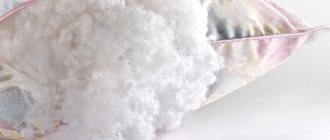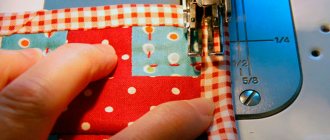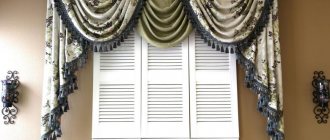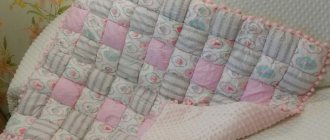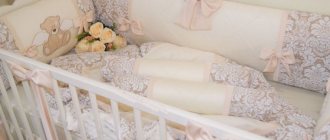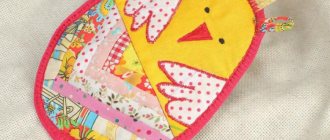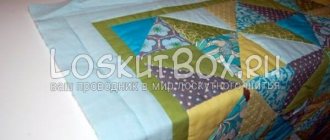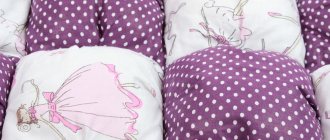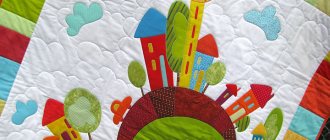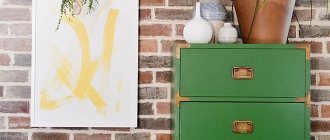A blanket is an extremely functional and useful item that should be in every home. Many people, in an effort to get rid of unnecessary hassle, simply purchase ready-made products in stores.
However, if a person wants to get a blanket that exactly matches all his preferences, it is better to sew it himself. Fortunately, the procedure for making a blanket is not as complicated as it might seem at first glance.
Which fabric is better to choose for sewing a blanket?
The first stage of designing a future blanket includes the selection of material. Almost all products of this type consist of three main parts:
- face - the surface of the blanket, most often directed outward;
- lining - the lining part directed towards the bed;
- filler is a kind of insulating material that gives the blanket volume and ensures heat retention.
The selection of each part must be approached with great care, taking into account the conditions of use of the item, its design and the funds that are planned to be invested in its manufacture.
The front side can be made from almost any fabric without any restrictions. Both natural materials and synthetics are suitable. When choosing a base material, you need to consider the following factors:
- Where to use the blanket. For a children's room, you need to select the safest and hypoallergenic options possible, while for use as part of outdoor activities, the primary condition will be strength.
- Compatible with filler. Synthetics will not be able to retain down or six, which act as insulation. So the front side of such a blanket needs to be made from natural cotton fabrics. If the filler is synthetic, then no problems with retention will arise even when using the cheapest polyester.
- Appearance. Ideally, the top of the blanket should harmonize with and complement the bedroom decor.
A variety of materials are also suitable for lining a blanket. But here you need to provide in advance the necessary density so that the filler does not cause discomfort. Also, complete hypoallergenicity and good breathability are important for this fabric.
The most common options for the lining are calico, chintz, satin and twill. Expensive solutions may use silk or bamboo fabric.
Note! Silk and satin are extremely slippery materials that can slide off a person sleeping in equally slippery pajamas.
Production technologies
In order to sew a blanket from padding polyester yourself, you need to choose high-quality material. To do this, you need to familiarize yourself with the methods of its manufacture. Let’s say right away that this filler can be made from both primary and secondary raw materials. Of course, good quality material can only be obtained in the first case. The fact is that when using primary raw materials, pure polyester fibers are used, to which natural fibers are sometimes added, for example wool or cotton. It is important to note that high-quality padding polyester consists of several layers that have different directions. This ensures high strength and durability of the material. Fillers made from recycled materials, of course, are low in price and not particularly high in quality. Often plastic bottles and even disposable tableware are used to make it! Experts note that such material deteriorates very quickly; after a couple of washes, it pills or gets knocked down.
Experts identify three methods for producing such filler as synthetic winterizer. The best material is obtained using the needle-punched method. If you are thinking about sewing a baby blanket from padding polyester, pay attention to the filler obtained using this technique. Wear-resistant filler is also obtained by using the so-called thermal method. In this case, the material is produced under high temperatures. The cheapest method is emulsion: synthetic fibers are bonded together using latex glue. The finished fabric is airy and incredibly soft, but cannot boast of particular strength.
How to choose filling for a blanket
An important part of any blanket is the filling. This insulating layer affects how comfortable a person will be under the covering item. Insulation materials can be natural, synthetic or mixed.
Wool, down, feather mixture or cotton are most often used as natural fillers. Synthetic analogues are represented by synthetic padding polyester, holofiber, synthetic down and fleece. A separate group includes mixed fillers such as cotton wool or batting.
Fillers of natural origin have increased heat-retaining properties, but they must be processed very carefully before use. Over time, even small traces of dirt can become food for bacteria and cause unpleasant odors.
All this will lead to allergic reactions and general discomfort. Additional difficulties with the use of natural fibers will arise when laying the material between the layers of the blanket. Without experience and professional equipment, this can be very difficult to do.
Synthetic fillers, produced in the form of cotton wool or rolls, are much more convenient to use. These are lightweight and durable materials that will not become an environment for the development of bacteria and do not cause allergies.
In addition, synthetics are available in a large number of varieties, and prices are significantly lower than those of natural fibers. But the main drawback here seems to be the insufficient softness of the filler in the first days of operation. The blanket may have difficulty maintaining its shape.
Mixed insulation materials created from textile waste and wool fibers deserve special consideration. The material is also supplied in the form of cotton wool or quilted fabric. The option is cheap and practically does not release heat.
However, making filler from waste leaves its mark: the material is not very aesthetically pleasing and over time can cause allergies due to the contaminants inside.
For these reasons, mixed materials are commonly used to make workwear or blankets for public use.
Positive sides
If you are seriously interested in the idea of sewing a blanket from padding polyester, you need to pay attention to the positive and negative qualities of the material. Among the advantages are its softness and airiness, heat-saving properties. Reviews of this filler often say that it is quite durable and elastic, capable of restoring its original shape. Of course, this is only possible if you choose high-quality material.
List of required tools and materials
To make your own blanket you will need the following tools:
- roulette;
- measuring tape;
- awl;
- tailor's pins;
- strong threads (smooth polyester thread No. 40 or No. 50 is suitable);
- needle for basting;
- a piece of chalk for marking;
- sewing machine.
It is important to prepare all the necessary materials and patterns in advance. This one applies to both sides of the blanket and the filling.
Bombon blanket: cozy DIY ideas and step-by-step master class
Childhood should be bright and colorful.
A blanket sewn with your own hands is a real gift not only for a child, but for any adult. Products using the bombon technique are most often created specifically for children, as they are soft, cozy and very pleasant to the touch. As for the appearance, this blanket looks very original, one might even say non-standard.
A magnificent novelty of recent years - a children's blanket using the bombon technique. The bombon blanket is recognized as a classic of modern design.
Pattern of different types of blankets
Immediately before sewing a blanket, you need to select or develop a suitable pattern.
When developing children's options, you can consider the option below:
So-called patchwork quilts, made up of small pieces of fabric, are widely popular. With the help of flaps you can create almost any design, guaranteeing the individuality of the product. Below are examples of quilt patterns.
When developing your own patchwork pattern, it is better to use checkered paper with known cell dimensions. In this case, the numbers will indicate the numbers of fabric colors in accordance with the selected samples.
There are a huge number of different patterns on the Internet, which most often are simplified drawings and pattern samples. Based on them, the user can develop his own pattern that suits his preferences and needs.
Below are typical quilt designs.
The final pattern for the work is created on tartan paper using full size blocks. Then the blocks are laid out and the desired visual effect is obtained. The color schemes applied to each block separately are also indicated. In the end, a complete drawing of the product is drawn on a sheet of paper, which indicates the dimensions and designations of the blocks.
The last point is often neglected even by experienced seamstresses, hoping for accuracy in drawing up a pattern in real size. However, if problems arise, localizing the error in this case will be very difficult.
Caring for synthetic winterizer
Now you know how to sew a blanket from padding polyester. But how to properly care for this product? The fact is that a blanket with such filling requires careful care. Only in this case will it last much longer without losing its positive qualities and properties. First of all, we suggest talking about how to wash a blanket with padding polyester filling. The water temperature in the washing machine should not exceed 40 degrees; the optimal mode for the product is delicate or hand wash. By the way, please note that regular washing powder for padding polyester-based blankets is not suitable. Instead, you should use a liquid product that contains a minimal amount of various chemical components. Don't forget to put tennis balls in the washing machine drum, which will prevent the product's filler from getting lost.
It would be a good idea to use a special cover, so you can prevent any damage to the fabric you used for the surface of the blanket. Products with synthetic padding should be dried on a clothesline in the fresh air. Proper care of your blanket is the key to ensuring that it will serve you for as long as possible without losing its original qualities!
Calculation of the required amount of material for various types of blankets
Most often, blankets are created for standard beds made in a factory. In this case, they start from the following dimensional values:
- Euro - 210x200 or 200x200 cm;
- Double – 210x180, 215x155, 175x200 or 220x240 cm;
- Single beds – 215x155 or 205x150 cm;
- Single beds – 200x150 cm;
- Children’s – 150x120 cm.
For the smallest newborn babies, the blanket is created according to the size of the changing table, taking into account the addition of 12-15 cm on each side. According to the standard, in this case a blanket is made 120x120 cm.
Calculation of fabric when sewing a blanket is carried out as follows:
- the width is determined by the width of the mattress, taking into account allowances;
- length along the length of the mattress, taking into account allowances;
- if an assembly border is not provided, then another 10 cm is added to the width, and 5 cm to the length.
Traditionally, when choosing the size of a blanket, they start from the size of the sleeping place. About 15-25 cm are added to these dimensions, which provides comfortable shelter for a person.
For cribs, the length of the blanket is most often 30 cm greater than the width. Standard sizes: 80x110 cm and 120x150 cm.
Moreover, in some cases, square versions of blankets, similar to products from a maternity hospital, are convenient. In this case, the dimensions of the final product will be 120x120 or 90x90 cm (for a stroller).
Separately, when developing a pattern for any blanket, it is worth adding seam allowances. This is about 1-1.5 cm of material in each direction.
Step-by-step instruction
- After you have determined the length and width of the blanket, cut out a rectangle, square or oval (you can choose the shape yourself) of the size you need from a piece of padding polyester. If you want to sew a multi-layer blanket, you will need two or three layers of filling. How to sew a blanket from padding polyester if its width is less than the width of the future product? Simply cut out a strip of the required size and sew it to the main piece. A simple closed stitch, which seamstresses call “forward needle,” is suitable for this. Of course, you can stitch an additional piece, but this is not at all necessary.
- After this, you need to stack all the layers of padding polyester on top of each other, and then align their edges. If any of the edges protrudes, you should carefully trim it. Using a needle-forward seam, join all layers of filling in the center, the blanket padding along the edge. Please note: the stitches can be quite large, this will not affect the quality of the future product.
- The next step is preparing the coating for the future product. Let's say you decide to make a rectangular blanket. Prepare the fabric - two sheets, leave a few centimeters for allowances, sew three sides of the rectangle and turn it right side out.
- The resulting cover must be carefully ironed, only then can filler be inserted into it. Carefully place the padding polyester inside, straighten it and fasten it. Large stitches or pins are suitable for this purpose. Please note: under no circumstances should you lose a single pin, otherwise you will hardly be able to sleep peacefully under this blanket. Therefore, if you took, for example, 15 pins, at the end of the work there should be exactly 15 of them left! Another condition: the sides of the gasket must perfectly match the side seams of the cover.
- Speaking about how to sew a blanket from synthetic padding polyester, it should be noted that it needs to be stitched along all the side seams, while capturing the padding.
- After this, fold the cut inside on the fourth side, also capturing the filler. Then you need to mark a line at a distance of 10-12 centimeters from all edges and carefully stitch the blanket again.
If you are thinking about how to sew a quilt with padding polyester, you should only carefully stitch it in the middle. You can do this with straight lines or squares, diamonds, making some kind of pattern, playing with the pattern that is applied to the fabric. The distance between the lines should be from 20 to 40 centimeters, and the lines should be neat on both sides of the product. The blanket is ready!
By the way, using the same technology you can make a simple sleeping bag that you can take with you on a long hike. You will also need a synthetic padding pad and two panels. On one of the short sides you will need to make a drawstring, bending 2-3 centimeters. When sewing the second short side and the sides, you will need to sew in the long zipper so that the open end is on the fold. After this, you will need to quilt the blanket, carefully stitch it along the edges, and insert a cord into the drawstring!
Practical or just pretty?
The “Bonbon” blanket is not just a unique thing, but also a practical accessory. Such a model will easily become a spectacular accent of the interior, emphasizing the sense of style of its owners. Moreover, the blanket will reliably cover and warm you.
The blanket, sewn in the bonbon style, is warm and light.
The product is truly multifunctional:
- Can be used for its intended purpose as a blanket.
- Some people prefer to use this accessory as a blanket or bedspread.
- Depending on the size, it can easily cope with the role of a cover for a chair, armchair, or ottoman.
- It quickly transforms into a blanket-cocoon, reliably covering you in an armchair or on the sofa.
- For a children's room it can be used as a rug for a baby who has just learned to sit. Tiny ottomans will soften the fall.
It can also be used as a mattress for a baby. It will reliably protect the baby from impact when falling.

